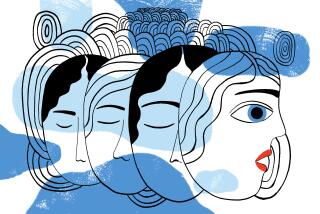The coat hanger, symbol of dangerous, pre-Roe abortions, is back
In the 1960s and â70s, as Americans argued over legalizing abortion, supporters of abortion rights sometimes held coat hangers aloft as an eloquent, grisly reminder that desperate women used them â and other methods -- for horrific, sometimes fatal self-induced illegal abortions.
In an April 1969 demonstration by more than 300,000 protesters in Washington, marchers wore coat hangers around their necks and held signs reading, âNever again.â
Maybe that symbol has faded from memory after 40 years of legal abortion, but not everyoneâs forgotten. A Washington nonprofit group is giving away a small coat-hanger pendant to anyone who donates to its fund to help poor local women pay for abortions.
WOMEN SPEAK OUT: âMy abortionâ
Out in the online world, offense â naturally â is being taken.
Some abortion opponents are trying to characterize this political statement as merely an ornament, a piece of jewelry that trivializes the matter. But it is no more an ornament or jewelry than the fetus-feet lapel pins bought and worn by abortion foes.
I suspect itâs the harrowing, silent power of the coat hanger image that they really object to. And a coat hanger is innocuous, compared to what some panicked pregnant women resorted to.
In 2003, on the 30th anniversary of Roe vs. Wade, I interviewed Dr. Daniel Mishell, the longtime chair of the ob-gyn department at USCâs Keck School of Medicine.
Decades ago, he worked at Harbor General Hospital and what is now L.A. County-USC Medical Center, in their septic abortion wards. Those places, he told me, were full of âthe sickest patients,â women who not infrequently died from using coat hangers or knitting needles or radiator flush to induce abortions.
Those, along with equally dangerous back-alley abortionists, were the choices, unless you were rich enough to get to someplace where abortions were safe and legal, like Sweden, where Mishell worked in 1961 and where he got calls from colleagues at home trying to arrange overseas abortions for their pregnant, prosperous patients.
In February 1882, The Times published an account of a young L.A. woman who died after trying to end a pregnancy with carbolic acid. One doctor testified that she had come to him for help, but, he said, âI did not propose to put my head in a noose for the $150 that she offered me.â
Even in the years following the Roe ruling, the coat hanger was used to make a point. In 1985, a UCLA fraternity was suspended after some of its members drove an RV from L.A. to a football game in Palo Alto with the image of a womanâs bloodied sexual organs and a coat hanger with the slogan âAbortionâYes!â painted on the RVâs side.
The Timesâ Pulitzer Prize-winning cartoonist Paul Conrad, a Catholic who came to favor abortion rights, went after critics of legal abortion with this 1988 cartoon showing the figure of Justice holding a coat hanger instead of scales. He employed the coat hanger again to mock President George H.W. Bushâs pro-gun, antiabortion position.
For todayâs young women, the coat hanger pendant may be the first time theyâve seen this symbol, but it wonât be the last. As the relentless closing of clinics in Texas and elsewhere, and the laws masquerading as concern for womenâs safety but in fact meant to stop safe, legal abortion continue into Roe vs. Wadeâs fifth decade, so will the coat hanger as a symbol of what was and what might be again.
ALSO:
Malaysia Air Flight 370: The spooky questions we still canât answer
Half of Americans believe in medical conspiracy theories. Thatâs dangerous.Morrison: Who cares if cops get in on the Bieber and Rihanna celeb buzz? You should.
Follow Patt Morrison on Twitter @pattmlatimes
More to Read
A cure for the common opinion
Get thought-provoking perspectives with our weekly newsletter.
You may occasionally receive promotional content from the Los Angeles Times.











